Recent Results of the MPE Infrared/Submillimeter Group
GRAVITY resolves the broad-line region in two more AGN
October 2021
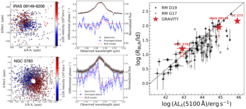
Building on our pioneering work studying the broad-line region (BLR) of 3C 273 with GRAVITY, we have recently published the results of two more studies of the BLR in IRAS 09149-6206 and NGC 3783. Using the same technique and modeling as for 3C 273, we have resolved the velocity gradient of the BLR for both of these nearby AGN and through modeling have measured BLR sizes of 89 and 16 light-days and black hole masses of 1.1x108 and 4.8x107 solar masses respectively. With an increasing sample, we can begin to test the radius-luminosity relation, which is a strong correlation between the BLR size and AGN luminosity that was established through reverberation mapping, an indirect technique for measuring the BLR size. This relation is extremely important, especially at high redshift, as it allows for a simple measurement of the BLR size and then the black hole mass. Our current GRAVITY measurements, which directly resolve the BLR, largely agree with the local radius-luminosity relation (see figure) although the offsets are real and hint at important structural differences. Through our GRAVITY Large Program, we will continue to observe more AGN and further investigate these deviations that suggest a diversity of BLR geometries and properties and determine how they depend on other AGN parameters.
Finally, an exciting new direction has also emerged: by combining interferometry and reverberation mapping data, we can directly measure the geometric distance (D) to AGN. While GRAVITY determines the angular size (ra) of the BLR on-sky, reverberation mapping provides the physical size (rp) through time lags. As D = rp / ra, the two measurements give the distance. In another recent publication, we have applied this method to NGC 3783 where we find a distance of 40 megaparsecs, in excellent agreement with other independent methods. Applying this to multiple AGN over a range of distances could also lead to another measurement of the Hubble constant, whose value remains in dispute between supernovae and cosmic microwave background estimates.
More information:
- GRAVITY Collaboration et al. 2020, Astronomy & Astrophysics, Volume 643, A154
- GRAVITY Collaboration et al. 2021, Astronomy & Astrophysics, Volume 648, A117
- GRAVITY Collaboration et al. 2021, Astronomy & Astrophysics, Volume 654, A85
Evidence for Cored Dark Matter Distributions in Galaxies at z ~ 1–2
October 2020
Using a set of very deep, spatially resolved kinematic observations from the KMOS3D, SINS/zC-SINF, and NOEMA3D surveys and additional data from LBT/LUCI, we have performed a kinematic decomposition analysis to constrain the separate bulge, disk, and dark matter halo mass profiles for 41 star-forming galaxies at z ~ 1–2 (“cosmic noon”).
In agreement with previous work, we find the galaxies are generally baryon-dominated within Re. However, the larger sample reveals an anticorrelation between dark matter fraction and baryonic mass (or baryonic surface density), with lower dark matter fractions in the most massive and most dense objects. The very low fDM(Re) of these objects provides evidence that their dark matter halos have cored profiles, with lower central densities than predicted for the NFW halo distribution. Such cored halo profiles could be caused by interaction effects between the baryons and dark matter, such as dynamical friction from the rapidly inflowing material building up central bulges and black holes at this epoch, or AGN-driven feedback processes.
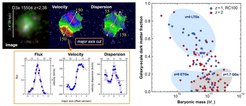
References:
- Genzel et al. 2020, ApJ, 902, 98 (http://ui.adsabs.harvard.edu/abs/2020ApJ...902...98G)
- Price et al. 2021, ApJ, in press (http://ui.adsabs.harvard.edu/abs/2021arXiv210902659P)
GRAVITY images the dust sublimation region in the nucleus of NGC1068
February 2020
A new GRAVITY data set of an active galaxy permits for the first time to image the nuclear hot dust in the sublimation region, i.e. the inner edge of the putative torus.

The observed properties of accreting supermassive black holes in active galactic nuclei (AGN) are determined by obscuring gas and dust. The size and structure of this obscuring, dust-emitting region in AGN is a long-standing issue: is it a torus or a disk, clumpy or in some other shape? What is the role of dust in winds and outflows? Direct observations of the nuclear dust structures are needed to reveal its nature and to study its role in unifying models of the varied AGN phenomena. However, circumnuclear dust in AGN is unresolved in single-dish images, causing a large uncertainty about the dust properties.
NGC 1068 at a distance of 14.4 megaparsecs is the prototypical Seyfert 2 galaxy. In particular, observations of NGC 1068 sparked the idea of a dusty torus surrounding a supermassive black hole. It has been the subject of numerous studies at high spatial resolution across the electromagnetic spectrum.
The near infrared is an ideal wavelength regime to study the dusty structures around AGNs as it is thought to trace hot dust just beyond the sublimation limit at its inner edge around the black hole. Our recent observations with the GRAVITY instrument on the European Southern Observatory Very Large Telescope Interferometer represent a giant leap in the study of the near-infrared emission. For the first time, we were able to reconstruct an interferometric image of the dust sublimation region (see figure) with an unrivalled resolution of 0.2 parscecs in the K-band. We find a thin ring-like structure of emission with a radius r = 0.24 ± 0.03 parsecs and an inclination i = 70 ± 5°, which we associate with the dust sublimation region. The observed morphology is inconsistent with the expected signatures of a geometrically and optically thick torus. Instead, the infrared emission shows a striking resemblance to the 22 GHz maser disc, which suggests they share a common region of origin. The dust structure and photometry are consistent with a simple model of hot dust at T ∼ 1,500 K that is behind AK ∼ 5.5 (AV ≈ 90) mag of foreground extinction. This amount of screen extinction could be provided by the dense and turbulent molecular gas distribution observed (e.g., by ALMA) on scales of 1 to 10 parsecs. Our new data represent another breakthrough result for GRAVITY on a classic AGN.
More information: Research paper: GRAVITY Collaboration: Pfuhl, O., Davies, R. et al. 2020, Astronomy & Astrophysics, Volume 634, A1
ALMA Reveals the Rapid Evolutionary Lifecycle of Star-Forming Regions in Galaxies
May 2019
Determining the physical processes controlling star formation in molecular clouds remains one of the main unsolved problems in astrophysics. New high-resolution observations of molecular clouds from ALMA and of the emission of young stars from the MPG/ESO 2.2 meter telescope for the nearby spiral galaxy NGC300 highlight the weak correlation of young stars and their parent clouds. This implies that the close correlation between molecular gas and star formation rate observed for whole galaxies and down to kpc scales – known as the Kennicutt-Schmidt or star formation relation – results from averaging over many star-forming relations. With a novel statistical model, we have shown that the observed decorrelation of young stars and molecular clouds holds valuable information on the time evolution of star-forming regions. For NGC300, we find that molecular clouds are short-lived (10 Myr or 1 dynamical timescale) and that a short period of active star formation (1.5 Myr) during which 2 to 3% of the cloud's mass is turned into stars releases sufficient stellar radiation and winds to disperse the parent molecular cloud. Star formation in molecular clouds proceeds very rapidly, yet highly inefficiently. This also explains the slow consumption of the galactic molecular gas reservoir by star formation of 1 Gyr in nearby galaxies because molecular gas has to evolve through many such cycles before it is fully turned into stars. We are now applying this analysis to a large number of galaxies in the nearby universe studied by the PHANGS collaboration and to first high-resolution observations of galaxies at high redshift during the peak of cosmic star formation.
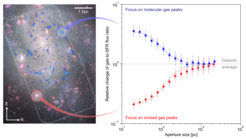
More information:
A Spatially Resolved Quasar Broad-Line Region
November 2018

Knowing the structure, size, and dynamics of the broad-line regions (BLRs) near accreting supermassive black holes would allow scientists to constrain the inward and outward transport mechanisms and to infer the mass of the black hole. So far, however, directly measuring BLR properties was impossible because of the small physical size of the BLR, on the order of hundreds of light-days (corresponding to an angular size < 1 milliarcseconds). With GRAVITY, we have now, for the first time, spatially resolved (10 microarcseconds or ~ 0.03 parsec for a distance of 550 megaparsecs) a velocity gradient across the BLR of the quasar 3C 273. The gradient reveals rotation perpendicular to the jet, and is consistent with line emission from a thick disc of gravitationally bound material around a black hole of 3x108 M☉. We infer a disc radius of 150 light-days, compared to 100 to 400 light-days found previously with reverberation mapping (RM). Thus, GRAVITY provides both a confirmation of RM (at least for this one object) as the main previous method to determine black hole masses in quasars and a new and highly accurate, independent method to measure such masses. In an approved VLTI Large Program, we will extend this study to a (small) sample of local AGN, and we are exploring options to expand it to larger samples and higher redshifts with potential upgrades of GRAVITY.
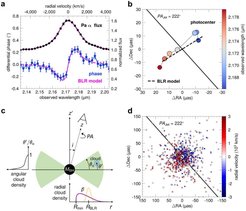
These images show our first BLR detection in 3C 273. GRAVITY observations of the broad Paα line emission exhibit the characteristic differential phase S-shaped signature (Panel a). The on-sky position of the Paα photo center as a function of wavelength reveals a velocity gradient perpendicular to the jet direction (Panel b), which is a clear signature of rotation. The data are well-described by kinematic models of Keplerian rotation in a thick disk configuration viewed at low inclination (Panel c). In particular, the best-fitting model image on sky matches the observed spectroastrometric pattern (Panel d, compared to panel b). This analysis allowed for robust measurements of the BLR radius and black hole mass.
More information: MPE press release
Measurement of Gravitational Redshift in the Galactic Center
July 2018
Sagittarius A* (Sgr A*), the massive black hole in the center of our galaxy, is the closest of its kind and the largest in the sky. It is surrounded by a cluster of high-velocity stars, called the S-stars, whose trajectories are governed by the gravitational field of the black hole. We used the Very Large Telescope (VLT) instruments GRAVITY and SINFONI to follow the short (16-year) orbit star S2/S-02 during its recent pericenter passage in May 2018, and collected astrometric and spectroscopic data, respectively. For the first time, these joint data allowed for a robust detection of the combined gravitational redshift and transverse Doppler effect on S2/S-02.
Gravitational redshift is one of the three classic tests of general relativity. Einstein's theory foresees that due to gravitational time dilation, a light beam is stretched to longer wavelengths by a gravitational field. The change in the wavelength of light from S2/S-02 is inconsistent with Newtonian predictions and in excellent agreement with Einstein’s general theory of relativity. On a technological level, the success of this measurement with GRAVITY/VLT opens the door to an entirely new type of laboratory to probe and test the theory: the Galactic Center.

More information: GRAVITY Collaboration, 2018A&A...615L..15G
Outflow Demographics and Physical Properties at z ~ 1–3
July 2018
Exploiting our full KMOS3D and SINS/zC-SINF surveys of near-IR IFU spectroscopy of z ~ 1–3 galaxies, we obtained the most complete census to date of galactic-scale ionized gas outflows at the peak epoch of cosmic star formation and AGN activity. The sample of ~ 600 primarily mass-selected galaxies spans wide ranges in stellar mass and star formation rate; the selection by mass, rather than by properties biased toward star formation (SF) or AGN activity, makes it ideally suited for a population-averaged characterization of winds as relevant to galaxy evolution. Compared to slit spectra, the IFU data greatly facilitate the separation between the broad outflow component in Hα+[NII]+[SII] and the narrower component from SF. Our studies show how outflows driven by SF and AGN are spatially, spectrally, and demographically distinct. SF-driven winds, launched near bright star-forming clumps across disks, have typical speeds of ~ 450 km/s below the hosts’ escape velocity except at log(M⁎/M☉) < 10.3; the prevalence of these winds depends on SF properties, not mass. AGN-driven winds originate from the nuclear regions, are ubiquitous in log(M⁎/M☉) > 10.7 galaxies hosting a massive bulge but rare at lower masses, irrespective of SF activity; with velocities of ~ 1,500 km/s, they can escape the galaxies. For the first time, the high S/N spectra constrain the density in high-z SF-driven winds from the broad [SII] doublet ratio, yielding ne ~ 400 cm-3; for AGN-driven winds, a higher ne ~ 1,000 cm-3 is inferred. These densities are a factor of several higher than previously assumed values, and lead to correspondingly more modest mass outflow rates ~ 0.1–0.4 x SFRs in warm ionized gas. The tension with theoretical work, requiring mass outflow rates ≳ SFRs to reproduce the observed relationships between galaxy mass and metallicity as well as galaxy mass and halo mass at log(M⁎/M☉) < 10.7, could be alleviated if substantial mass, momentum, and energy were ejected in hotter and/or colder phases than the ~ 104 K ionized gas probed by our data. The fast, high-duty-cycle AGN-driven winds at high masses carry significant energy (~ 1% that of the AGN), which may contribute to heat halo gas and help prevent further gas infall. Our results are consistent with recent EAGLE and Illustris/TNG numerical simulations, which suggest that such a mechanism, acting also at the modest luminosities and Eddington ratios of the majority of the KMOS3D and SINS/zC-SINF AGN, may be more effective at widespread and long-term quenching than ejective "QSO mode" feedback in rare, high-luminosity, high-Eddington-ratio AGN.
![These images show the spatial distribution, spectral properties, and demographics of SF- and AGN-driven galactic winds (top and bottom rows). From left to right: maps of two example galaxies from SINFONI+AO and HST (FWHM physical resolution of ~ 1.8 kiloparsecs), composite spectra from our KMOS3D and SINS/zC-SINF samples, and the fraction of galaxies exhibiting the broad Hα+[NII]+[SII] outflow signature as a function of galaxy stellar mass and offset in SFR relative to the main-sequence relationship.](/7230638/original-1623223849.jpg?t=eyJ3aWR0aCI6MjQ2LCJvYmpfaWQiOjcyMzA2Mzh9--5ff37fc67c937bb0dc551bad80eef5f509277c21)
These images show the spatial distribution, spectral properties, and demographics of SF- and AGN-driven galactic winds (top and bottom rows). From left to right: maps of two example galaxies from SINFONI+AO and HST (FWHM physical resolution of ~ 1.8 kiloparsecs), composite spectra from our KMOS3D and SINS/zC-SINF samples, and the fraction of galaxies exhibiting the broad Hα+[NII]+[SII] outflow signature as a function of galaxy stellar mass and offset in SFR relative to the main-sequence relationship.
More information: Research paper: Förster Schreiber, Übler, Davies et al. 2019, ApJ, 875, 21
Scaling Relations for Molecular Gas in Galaxies over Cosmic Time
February 2018
We have developed new statistically robust scaling relations between galaxy-integrated molecular gas masses, stellar masses, and star formation rates (SFRs) relative to that on the main sequence (δMS). Combining data from our PHIBSS and xCOLDGASS surveys with information available in literature, we use three independent methods to determine molecular gas masses: 1) CO line fluxes, 2) Herschel far-infrared dust SEDs, and 3) ~ 1 mm dust photometry, in a large sample of 1,444 star-forming galaxies and stacks between z = 0 and 4. The sample spans stellar masses from log(M⁎/M☉) = 9.0–11.8, and SFRs relative to that on the MS, from 10-1.3 to 102.2. The most important result is that all data sets follow the same scaling trends, once we account for uncertainties and apply consistent methodologies. The molecular gas depletion time tdepl, defined molecular gas mass/star formation rate, scales as (1+z)-0.6 x (δMS)-0.44, and is only weakly dependent on stellar mass. The ratio of molecular to stellar mass μgas depends on (1+z)2.5 x (δMS)0.52 x (M⁎)-0.36, and tracks the evolution of the specific SFR.
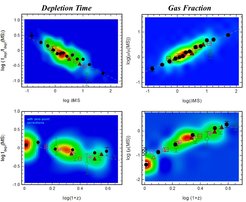
These images show the scaling of tdepl (left) and μgas = Mmolgas/M⁎ (right) with redshift (bottom) and SFR relative to that on the main sequence, δMS (top). The colors illustrate the overall distribution of our data, and the large symbols are binned averages for the different gas mass determination methods (CO: black circles, dust SEDs: unfilled symbols, submm continuum: brown filled triangles). The dashed lines are the best global, multiparameter fits to the data.
More information:
- Research paper: Tacconi et al. 2018 ApJ 853, 179
- Research paper: Genzel et al. 2015 ApJ 800, 20
- Research paper: Tacconi et al. 2013 ApJ 768, 74
Strongly Baryon-dominated Disk Galaxies at the Peak Epoch of Galaxy Formation
March 2017
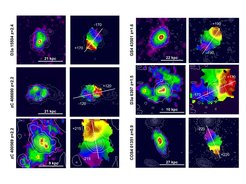
New observations of rotating galaxies at z ~ 2, the peak epoch of galaxy formation, show that these massive star-forming galaxies are strongly dominated by baryonic mass, with dark matter playing a much smaller role in comparable regions of their outer disks than in typical present-day spiral galaxies. This result was obtained from observations of unprecedented sensitivity with the SINFONI and KMOS near-IR integral field spectrometers, mapping the 2D kinematics of ionized gas through the Hα line emission of six galaxies out to two to three times their half-light radius. On these scales, dark matter starts to dominate the total mass budget in z ~ 0 late-type galaxies, causing their rotation curves to stay mostly flat or slightly increase with radius. In contrast, the six individual massive z ~ 2 galaxies in our study exhibit declining rotation curves, which can be explained by the combination of two factors: baryons dominate more strongly than dark matter on galactic scales, and the elevated gas turbulence characteristic of z ~ 2 disks provides a significant amount of the dynamical support, thereby leading to a decrease in the rotation velocity. Such a falloff with radius is further seen in the average outer rotation curve derived through a novel stacking technique of ~ 100 typical massive z ~ 1–2.5 disk galaxies observed with KMOS and SINFONI, suggesting that it is a common feature among the star-forming population in these epochs. Two additional studies of the resolved inner disk kinematics (out to 1–1.5 half-light radius or the velocity turnover radius) of 240 star-forming disks support the results based on the outer rotation curves. Detailed dynamical modeling shows that while the stars and gas account on average for ~ 56% of the total enclosed mass at z ~ 1–2.5, the baryon fraction reaches ~ 90% at the higher redshifts, and is largest in disks with highest central baryonic mass surface density. The evolution of the zero point of the stellar and baryonic Tully-Fisher relationships based on the same data is further compatible with the increase in gas and baryon mass fractions with redshift, with a lesser role of dark matter in the central disk regions. The low-galactic-scale dark matter fractions found in massive high-redshift galaxies in these studies are comparable to those of present-day massive early-type galaxies, their likely descendants. The high gas fractions in z ~ 2 star-forming galaxies could help to dissipate angular momentum, efficiently driving gas inward and leading to the strong dominance of baryons early on.
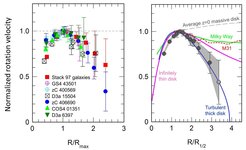
More information:
- MPE press release
- Research paper: Genzel et al. 2017, Nature, 543, 397
- Research paper: Lang et al. 2017, ApJ, 840, 92
- Research paper: Übler et al. 2017, ApJ, 842, 121
- Research paper: Wuyts et al. 2016, ApJ, 831, 149
KMOS3D Survey of Spatially Resolved Gas Kinematics, Star Formation, and ISM Properties Sheds New Light on the Physics of Galaxy Evolution
June 2016
Our comprehensive and highly successful multi-year KMOS3D survey takes advantage of the efficient multiplexing of the new near-IR 24-IFU KMOS instrument at the Very Large Telescope to spatially resolve the ionized gas kinematics, star formation, outflows, excitation, and metallicities of a large and homogeneous sample of z ~ 0.7−2.7 mass-selected galaxies. KMOS3D is a 75-night Guaranteed Time Program started in November 2013 and led by the MPE Infrared/Submillimeter Group and MPE/OPINAS and USM. After 2.5 years and 52 nights of productive observing campaigns, the sample has now reached 564 galaxies, with an overall Hα detection fraction of 80% (and as high as 90% for main-sequence star-forming galaxies). The survey was carried out in well-studied extragalactic fields, benefitting from extensive multiwavelength data that include the far-IR Herschel PEP survey and high-resolution near-IR/optical grism and imaging data from the 3D-HST/CANDELS HST Treasury programs. KMOS3D is designed to provide an unbiased census from deep integrations (~ 5 to 25 hours) of the Hα+[NII]+[SII] line emission resolved on seeing-limited scales of 4 to 5 kiloparsecs, over a wide range of galaxy parameters and five billion years of cosmic time. The strategy is uniquely enabling faint-line emission mapping in individual objects and pushing near-IR IFU studies into new regimes, such as lower-mass star-forming galaxies and high-mass submain-sequence galaxies in the process of quenching. The ighlights of our results are shown in the figure below. They robustly confirm the earlier findings from our SINS/zC-SINF near-IR IFU survey with SINFONI on the majority of disks among high-z star-forming galaxies and their elevated gas turbulence compared to present-day spirals, and on the ubiquity and origin of powerful AGN- and star-formation-driven gas outflows. They also provide new constraints on the angular momenta, baryonic mass fractions, outer disk structure, the relation between mass, metallicity, and star formation, and gas phase O/H abundance gradients. Furthermore, our results shed new light on dense core formation and star formation quenching in high-mass galaxies.
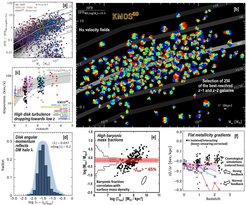
More information:
- Research paper: Wisnioski et al. 2015, ApJ, 799, 209
- Research paper: Burkert et al. 2016, ApJ, 826, 214
- Research paper: Wuyts et al. 2016, ApJ, 831, 149
- Research paper: Wuyts et al. 2016, ApJ, 827, 74
ALMA Reveals Planetary Construction Sites
December 2015
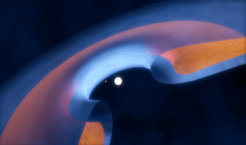
By using the Atacama Large Millimeter/submillimeter Array (ALMA), we have discovered the clearest indications yet that planets with masses several times that of Jupiter have recently formed in the discs around young stars. New images of transitional discs show that there are significant amounts of gas within the dust gaps, and that the gas also possessed a gap, which was up to three times smaller than that of dust. This can only be explained by a scenario in which newly formed massive planets clear the gas as they travel around their orbits, but trap the dust particles further out. The data rule out other scenarios for the observed set of discs.
More information: ESO press release
Evidence for Widespread AGN-Driven Outflows in the Most Massive z ~ 1–2 Star-Forming Galaxies
November 2014
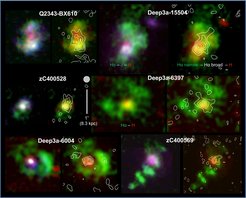
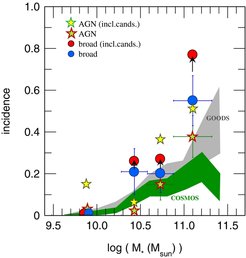
This figure shows the incidence of AGN in massive z ~ 1–2 star-forming galaxies. All indicators suggest a rise with stellar mass, but the incidence of AGN-driven outflows (blue and red filled circles) is larger than traditional X-ray/optical/IR evidence for AGN in the same galaxies (stars) or similar evidence in large samples in well-studied extragalactic deep fields (shaded bands).
Very deep laser guide star-assisted adaptive-optics observations allowed us to detect ubiquitous powerful nuclear outflows in massive (1011 M☉) z ∼ 2 star-forming galaxies, which are plausibly driven by an active galactic nucleus (AGN). The spectra in their central regions exhibit a broad component in Hα and forbidden [NII] and [SII] line emission, with typical velocity FWHM ∼ 1,500 km s-1, high [NII]/Hα ratio ~ 0.6, and intrinsic extent of 2 to 3 kiloparsecs. At larger radii, weaker and less wide broad components suggest star-formation-driven outflows. The high inferred nuclear mass outflow rates and frequent occurrence suggest that the nuclear outflows efficiently expel gas out of the centers of the galaxies with high-duty cycles, and may thus contribute to the process of star formation quenching in massive galaxies. Extending to a large sample observed without adaptive optics, we find that the incidence of the most massive galaxies with broad nuclear components is at least as large as that of AGNs identified by X-ray, optical, infrared, or radio indicators, as expected for rapidly varying AGN whose outflows are visible with larger-duty cycle than X-ray or optical continuum. The mass loading of the nuclear outflows is near unity. Our findings provide compelling evidence for powerful, high-duty-cycle, AGN-driven outflows near the Schechter mass, that act across the peak of cosmic galaxy formation.
More information:
- Research paper: Förster Schreiber et al. 2014, ApJ 787, 38
- Research paper: Genzel et al. 2014, ApJ 796, 7
Molecular Gas, Extinction, Star Formation, and Kinematics in the z = 1.5 Star-Forming Galaxy EGS130111661
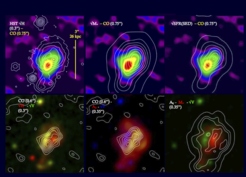
In the top row, the molecular gas is shown as the backdrop image in color and the contours display the stellar light (from left to right: H-band map, stellar mass, and extinction-corrected star formation rate). In the bottom row (center image), the backdrop shows the extinction, and the white contours show the CO-integrated flux map – demonstrating how well the absorption seen in the rest-frame optical light coincides with the CO emission. The high-resolution HST H-band maps show clumps of star formation, typical for galaxies at the peak of the cosmic star formation rate (see results from the high-redshift galaxy survey SINS).

This image shows a comparison of CO (IRAM/PdB) and Hα (LBT/LUCI) data at the same resolution of FWHM 0.75 arcseconds. There is a remarkable agreement between the kinematics as derived from the molecular (traced by the submm CO line) and ionized gas (traced by the Hα line) that shows that both tracers can be used equally well to study rotation curve and kinematics in high-redshift galaxies.
As a follow-up to the high-redshift molecular gas survey PHIBSS (Tacconi et al. 2013; see news item below), we carried out a detailed analysis of one of the most massive galaxies in this survey. For the study of the galaxy named EGS13011166, CO 3-2 line observations from the IRAM Plateau de Bure millimeter interferometer were combined with Large Binocular Telescope (LBT) LUCI observations of the Hα line in this galaxy, at matched spatial resolutions of 0.75 arcseconds. The galaxy was scanned perpendicularly to the slit with LUCI to obtain spectra that are spatially resolved both along and perpendicular to the slit. Additionally, we used Hubble Space Telescope (HST) V-, I-, J-, and H-band maps. Together, these data allow us to derive the stellar surface density and star formation rate, molecular gas surface density, optical extinction, and gas kinematics.
More information: Research paper: Genzel et al. 2013, ApJ, 778, 68
New Observations on the Galactic Center Gas Cloud "G2"
September 12, 2012
New observations on the gas cloud "G2" falling toward the Galactic Center confirm its highly elliptical orbit, but with updated orbital parameters. As new data show, the cloud is now expected to come even closer – the updated pericenter distance is 2200 Schwarzschild radii – to the supermassive black hole at the center of our galaxy. While its origin is still unclear, its apocenter is near the inner edge of the disk of young stars. This supports speculations that the cloud, which has a mass of only about three earth masses, originated as a wind of one of these stars.
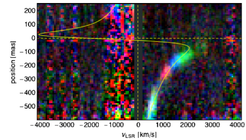
In the course of this year, we have planned more observations of the cloud, of course, and not only in the infrared area. Many groups have started campaigns to observe this accretion event in the whole electromagnetic spectrum. A wiki page has been set up to collect all information on "G2."
More information: Research paper: Gillessen et al. 2013, ApJ, 763, 78
Galactic Black Hole Disrupts Gas Cloud
December 14, 2011

Image: MPE
Over the next few years, astronomers will be able to observe first-hand how the supermassive black hole at the center of our Milky Way is being fed: an international team of astronomers led by the Max Planck Institute for Extraterrestrial Physics has found a gas cloud that is falling toward the black hole in the Galactic Center. While some distortion due to the huge gravitational pull of the black hole can already be seen, the gas cloud will be completely disrupted and ultimately swallowed by the black hole, resulting in largely increased X-ray emission. The observations and analysis are described in a Nature paper, published online on December 14, 2011.
More information: MPE press release
Caught in the Act: Herschel Detects Gigantic Storms Sweeping Entire Galaxies Clean
May 9, 2011
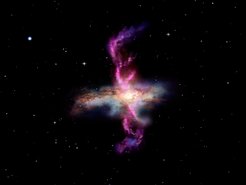
Image: MPE
With observations from the PACS instrument on board the ESA Herschel space observatory, an international team of scientists led by the Max Planck Institute for Extraterrestrial Physics has found gigantic storms of molecular gas gusting in the centers of many galaxies. Some of these massive outflows reach velocities of more than 1,000 km/s, i.e., they are thousands of times faster than the ones in terrestrial hurricanes. The observations show that the more active galaxies contain stronger winds, which can blow away the entire gas reservoir in a galaxy, thereby inhibiting both further star formation and the growth of the central black hole. This finding is the first conclusive evidence for the importance of galactic winds in the evolution of galaxies.
More information: MPE press release







![These images show the spatial distribution, spectral properties, and demographics of SF- and AGN-driven galactic winds (top and bottom rows). From left to right: maps of two example galaxies from SINFONI+AO and HST (FWHM physical resolution of ~ 1.8 kiloparsecs), composite spectra from our KMOS3D and SINS/zC-SINF samples, and the fraction of galaxies exhibiting the broad Hα+[NII]+[SII] outflow signature as a function of galaxy stellar mass and offset in SFR relative to the main-sequence relationship. These images show the spatial distribution, spectral properties, and demographics of SF- and AGN-driven galactic winds (top and bottom rows). From left to right: maps of two example galaxies from SINFONI+AO and HST (FWHM physical resolution of ~ 1.8 kiloparsecs), composite spectra from our KMOS3D and SINS/zC-SINF samples, and the fraction of galaxies exhibiting the broad Hα+[NII]+[SII] outflow signature as a function of galaxy stellar mass and offset in SFR relative to the main-sequence relationship.](/7230638/original-1623223849.jpg?t=eyJ3aWR0aCI6ODQ4LCJmaWxlX2V4dGVuc2lvbiI6ImpwZyIsIm9ial9pZCI6NzIzMDYzOH0%3D--471b413d350050974867edfc5faa4fb0f648edbe)











